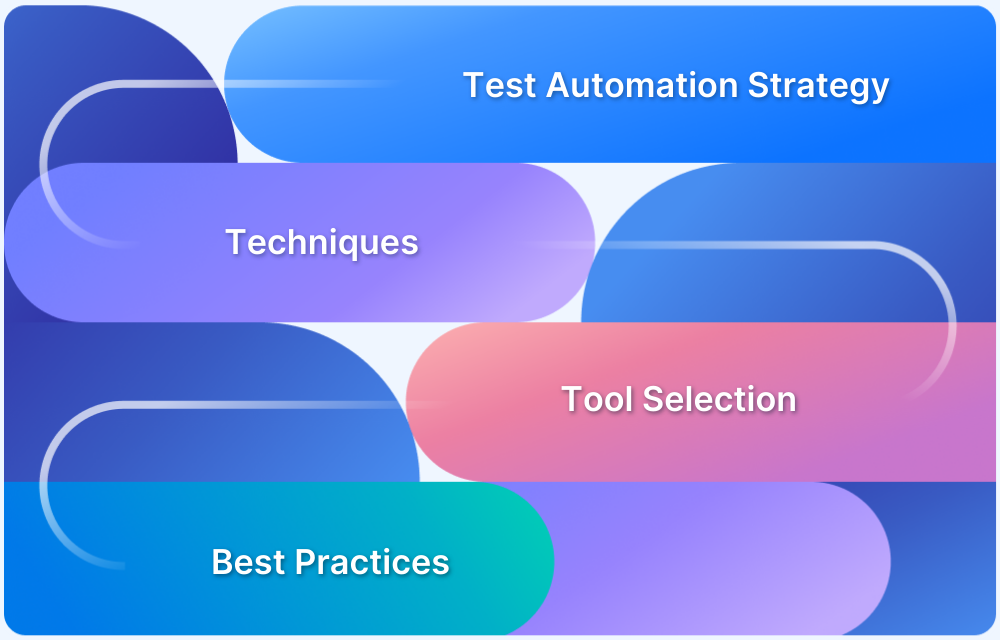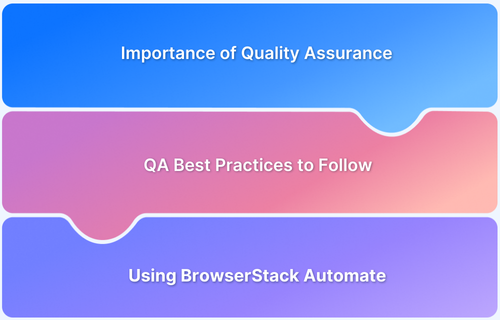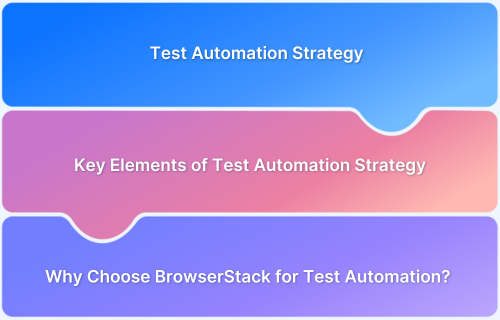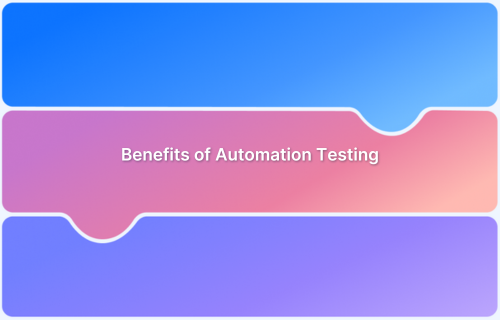Test automation has become a critical practice in modern software development, helping teams accelerate release cycles, improve accuracy, and integrate seamlessly with agile and DevOps workflows. While manual testing still plays a role, relying solely on it can slow down delivery and limit efficiency.
Overview
Test Automation at a Glance
- Not 100% achievable but essential to balance manual + automated testing.
- Drives speed & accuracy in agile and DevOps pipelines.
- Needs strategy to avoid wasted effort, wrong tools, or poor ROI.
Why Automation Test Strategy Matters
- Prevents loss of business value (no ROI = no buy-in).
- Defines vision & long-term goals.
- Avoids wrong tools/tech choices.
- Helps with risk analysis & mitigation.
Best Practices to Build a Strategy
- Define Goals → Align automation scope, ROI, and roadmap with business needs.
- Test Approach Planning → Use the test pyramid (Unit → API → UI → E2E). Include cross-browser + cross-platform testing.
- Choose a Framework → Options: Record & Playback, Data-driven, Keyword-driven, POM, Modular, Library, BDD, Hybrid. Pick what fits your team’s skills & goals.
- Evaluate & Choose Tools → Don’t chase the “best” tool; pick the right one for your org. Validate via POC + CI/CD fit.
- Test Environment Setup → Define data storage, execution, reporting, and environment (dev/staging/prod).
- Risk Analysis → Identify risks early (credentials, environment issues) + define mitigation plans.
- Team Strategy → Roles, sprint planning, reviews, and collaboration approach.
- Learning Goals → Account for tool learning curve, productivity dips, and upskilling.
- Create, Execute, Maintain Tests → Start small, automate critical features, update scripts continuously.
- Execution & CI/CD Integration → Define suites (smoke, regression, sanity). Automate runs with DevOps pipelines.
- Reporting → Simple, visual, non-technical reports for stakeholders. Include trends & storage plan.
- Review & Retrospect → Continuously refine scripts + strategy. Avoid bias, seek feedback, and iterate.
This guide explains what test automation is, why an automation strategy is essential, and the best practices for building a robust test automation framework that drives long-term business value.
What is Software Test Automation?
Software Test Automation is programmatically verifying the expected result and actual result without manual intervention. Test Automation needs specialized testing tools to write and execute the scripts.
This brings us to the next question – Why do you need automation testing? Manual testing is time-consuming and resource-heavy. Modern software development processes are automated, and this helps accelerate the release cycles.
With manual testing, the release should be held up until you hear from the testing team. Though the development is completed on time, testing can slow down your release. On the other hand, automation testing doesn’t take much time and resources.
Advantages of Automation Testing include:
- Saves cost
- Fast Development and Delivery
- Accurate Results
- CI/CD or DevOps Integration
Why do we need a Test Automation Strategy
The Test Automation Strategy defines the success of test automation, and a well-defined automation strategy yields the best results. The organization/team should spend a good amount of time defining strategy. Without a good automation strategy, automation can lose focus.
Listed below are a few things that can go wrong in absence of an automation strategy.
- Loss of Business Value: If the test automation framework doesn’t bring any business value, then Return On Investment(ROI) will be negligible. No organization supports something which doesn’t get business value or if there is no Test Automation ROI. Automation strategy should be clearly defined in a way that brings higher business value than expected.
- Lack of Vision: The automation strategy defines the long-term goal and vision, without which you might end up bringing multiple tools and scrapping them more frequently.
- Wrong Technology: In the absence of an automation strategy, you will end up using the wrong tools and technology. If you choose the wrong tech stack and tool, in the longer run, you might face a lot of challenges, or you might even need to scrap existing and build something new from scratch.
- Risk Analysis: The strategy also helps to predict the risk involved in test automation. The strategy will have information about if there is a risk, how it can be optimized, workarounds, and alternatives. Without a strategy, you will have no clue of the risk which can arise in the future; when it arises, it may be too late for you to find the solution. Read about Risk-Based Testing in Agile.
Best Practices to build a Test Automation Strategy
1. Define Goals
Before starting automation, you need to be clear about your long-term and short-term goals of test automation. You should clearly put the road map and discuss it with higher management and stakeholders. Some of the pointers might help you to define the goal.
- Why are we considering test automation for this project
- The expected business value from automation or ROI
- The scope of automation
- A high-level procedure to deliver the automation
- The planned percentage of automation (In a gradual manner ex: quarter wise)
- The end goal of automation
2. Test Approach Planning
There are different levels of testing, many times automation is confused with end-to-end testing, but there are many levels. The best approach is to create test pyramids.
- Unit Testing: Unit Testing is the backbone of the automation strategy, and false failures are very less. Though Unit testing is part of white box testing, having good coverage of unit testing reduces the regression. Unit testing should be mandatory for any features that are being developed. The modern infrastructure provides an option to put the quality gate where you can define the minimum percentage of Unit Test coverage before pushing it to the repository. The Unit Testing coverage percentage typically ranges from 80% to 90%; however it depends on the application framework, complexity, and type of application.
Also Read: How do you ensure maximum test coverage?
- Integration and API Testing: Nowadays, almost all organizations follow API-driven architecture for development. API testing acts as middle-level or integration testing, and it’s easy to achieve. The clear API testing technique produces great output. API testing helps to validate the business logic to a great extent. In the absence of an API, consider having integrated component testing.
- UI Testing: UI testing focuses on UI elements. Visual Validation testing is one example of UI Testing. The UI testing mostly validates the styles, layouts, alignments, fonts, etc. The well-defined UI testing helps to reduce UI bugs and provides a smoother User experience (UX).
- End to End Testing: The most focused area in test automation, end-to-end testing focuses mostly on functionality and workflow. The end-to-end testing mostly replicates the user behavior using simulation. This is the exact replacement for manual testing. End to end Testing should be well written. This also requires timely maintenance to produce accurate output, so while defining a strategy, you need to consider it.
Other Areas of Testing to Focus on:
- Cross Browser Testing: The Testing team needs to work with the product and business team to understand the cross browser requirements. Your application should be compatible with different devices such as Chrome, Firefox, Edge, Safari, etc.
- Cross Platform Testing: The Cross browser can be multiple browsers on the same operating system or multiple browsers on multiple operating systems; if the application is supported by multiple operating systems such as Windows, Mac, Linux, iOS, Android, etc, then you need to define the plan to achieve them. You need to consider both the native app and browser. You can consider a cloud-based platform like Browserstack to achieve such requirements with ease.
Read More: How to set up QA processes from scratch
3. Choose a Framework
Once you know the business value, the most critical part is the type of framework you choose. There are different types of automation frameworks; you need to discuss them with the team and choose the right one.
Linear Automation Framework (Record & Playback)
The record and playback framework works when the user simply records the tests and executes them after. The record and playback tools are well suited for beginners. The record and playback tool is not recommended as it has a lot of limitations.
Pros:
- Easy to set up
- Easy to automate the scripts
- Less technical knowledge required
Cons
- Requires a lot of maintenance
- Almost impossible to use in the long run.
Data-Driven Test Framework
The data-driven testing simply separates the data and actual tests. In a data-driven framework, the data is stored in external files like CSV, JSON, etc., and later it is used in your script dynamically.
Pros:
- This framework is best when your application has frequent changes in data
- Running the same tests with multiple sets of data is easy and requires less effort
Cons:
- The data-driven framework requires good technical skills
- Need to spend time separating data, preparing data files, and using them in your scripts.
- Code reuse will be limited
- Consumes more time
Keyword driven framework
In Keyword driven framework, the keywords are mapped with the action performed on GUI. For example, the keyword “enter the username” types the username on GUI. The keywords are separated from testing logic and stored separately whenever the keyword is encountered, the mapped functions will be called to perform actions.
Pros:
- The keyword-driven framework helps to achieve a high degree of code reuse.
- Easy to use for beginner-level testers.
Cons:
- Keyword driven framework is time-consuming
- High setup cost.
- Rich technical expertise is required.
Page Object Model
Page object model is the most popular framework design strategy in automation. It is also called POM. The page object model creates the object repository for storing the HTML elements. The HTML elements (Objects) of each web page are stored in a separate file; then, the page objects will be used for creating test scripts.
Pros:
- The page object model offers increased code reuse.
- Ease of maintenance
- Good readability
Cons:
- The Page object model cannot be used for multiple projects as it is not generic
- Takes time to set up
- One should be technically skilled to set up the framework
Modular driven framework
The modular-driven framework divides the test case into small modules. The module can be a small set of functions, or a set of features, that the application has. Tests are created individually and combined to make a larger test suite. The master script generally calls the required scenarios/modules.
Pros:
- Ease of maintenance
- Easy to develop the test script as they are smaller
Cons:
- The setting up framework can be challenging
- Hard-coded data ends up duplicating tests
Library architecture framework
The library architecture framework is similar to a modular-driven framework; In addition to a modular-based framework feature, it provides the additional benefit of common functions. Similar tasks which can be reused in multiple places are separated and stored in common files/directories.
Pros:
- Provides a high amount of code reuse
- Maintenance doesn’t require much time
Cons:
- Expert-level technical skills are required to achieve this framework.
- Writing common libraries and separating them makes the framework more complex.
- Reduced readability
Behavior Driven Framework
The BDD frameworks use the gherkin language format (Given, when, then). The acceptance criteria given by the product team will be mapped to the test cases. The BDD framework contains the feature files. Each feature file will have a set of scenarios in plain English language. These scenarios in the feature files are mapped to the step definition files to write the execution logic.
Pros:
- Clearly defined scenarios
- Good level of code reuse
- Easy to understand for non-technical teams
- Easy to map the data into test scripts
Cons:
- Test case creation takes time
- Difficult to maintain
- One needs to understand the requirement clearly before writing the test cases.
Read More: BDD vs TDD vs ATDD: Key Differences
Hybrid framework
The Hybrid Framework can be a combination of any of the above-mentioned frameworks; as you are aware that every framework has some advantages and disadvantages. Based on the required set of features, one can combine the above type of framework to create a hybrid framework.
Pros:
- Adds flexibility to your framework
- Increases the code reusability
- Easy to maintain
- Customization of reports and analysis
Cons:
- Requires in-depth understanding of testing
- One must be highly skilled to achieve this framework
- A poorly designed framework can become worthless to an organization
4. Evaluate and Choose the Tool
The testing tool should be carefully evaluated, and pick the right tool. Remember, “Never choose the best testing tool in the market; always choose the best testing tool for your organization”. That means the best tool in the market may not be the best fit for your organization.
While evaluating a testing tool, you must consider multiple things, such as
- The scope of the test automation tool
- Expected functionality from the test automation tool
- Supported platforms/browsers
- Need to evaluate if it fits your domain
- Cost
- The programming language support
- Community support and documentation
- Learning involved
The automation tool evaluation is typically done by picking a set of tools that fit best into your organization/team and then by performing the Proof of concept (POC) to decide.
The tool will be evaluated by answering a set of questions as mentioned above and then by writing a small few test cases. The proof of concept can also involve integrating with CI/CD pipeline to evaluate how well it fits into the DevOps framework.
Once you evaluate and choose the tool, you must discuss it with management by clearly showcasing facts such as limitations, advantages, etc. One must not be biased based on his expertise and learning, the tool must be evaluated as per the organization’s requirement.
5. Test Automation Environment
You need to be very clear about where the test data will be stored, where the automation execution takes place, how the report will be stored and shared, how long the old report will be stored etc. You should also know which environment the application under test will be used for validation, such as dev, staging, production, or all of these, etc.
If you are adopting DevOps practices, then the configuration and triggers of the pipeline come in place.
6. Risk Analysis
It is essential to analyze the risk and communicate it to management. Automation testing may have some risks based on the tools and strategy you are using. For example, if you are creating a separate credential for test automation and if you decide to use the production environment, then imagine the risk. If such a risk occurs, what is the mitigation plan? Before starting to test automation, you should predict the risks that automation brings and the mitigation plan, etc.
7. Define Automation Team Working Strategy
This is the high-level approach to planning the automation; this includes who is playing what role. You can follow the sprint-1 strategy for automation. It can also include automation test case review processes.
- Team members’ roles and responsibilities, who will be heading, point of contact, etc.
- When test cases are automated, for example, same sprint or sprint – 1
- How the testing members are divided, some follows a separate automation team, some combine manual and automation testers, and some organization follows the scrum team, where dedicated automation members for each team.
8. Learning Goals
The learning curve has to be evaluated while choosing the tool; if you are switching from one tech stack to another, or initiating a manual tester to automation tester transition, then there is learning involved in it. When there is learning involved, productivity cannot be 100% as team members need to spend time learning. So, you need to set a goal for learning. The management should also be aware of this, as productivity may not be as expected until the learning completes.
9. Create, Execute and Maintain Tests
You have chosen the tool and technology. The right tool is in place; at this point, you can bring automation into reality by implementing them.
- Start creating the automation scripts.
- Decide upon what can be automated and what cannot.
- Start with the most critical features and quick wins.
Once you create the test cases, execute them often. Timely maintenance is expected for automation test cases as there will be active development in the background.
Create, execute and maintain repeats as your day-to-day work.
10. Execution Plans and DevOps Integration
Once you have the test automation scripts ready, you need to plan for execution.
- Consider creating test suites like smoke, regression, sanity, etc.
- Define execution strategy; for example – smoke needs to run every day, regression twice a week, etc.
- Have a feature-wise test suite; whenever there are feature changes, there is no need to execute the whole regression suite; one can just execute only the required test suites.
- Consider DevOps integration which makes testers’ and developers’ jobs easier.
- The DevOps integration also reduces the dependency of the testing team; anybody can execute and get the report.
11. Reporting
The reporting is most important in the test automation tool.
- The reporting should not contain any technical details as it may confuse the stakeholders.
- The report must have numbers of total test cases, passed, failed, etc.
- Consider having graphs, trends, etc., to make the report more attractive.
- The report must be clearly understandable for any non-technical person
- You must define a strategy around report sharing, like recipients, when to share and how often, etc.
- Store a report in a commonplace; one should be able to access it anytime when needed.
Read More: Top 5 Selenium Reporting Tools
12. Review, Analyze and Retrospect
This is a never-ending task; you need to continuously review your test scripts, understand what is causing false failures, and understand what is impacting test case creation. How can you do it better? This task is not only for test case creation. This may include modifying the whole automation strategy as well, but this should not deviate from your original goals.
Test automation can be the only way of testing in your organization; the success of test automation depends on how well the strategy is defined and how it is implemented. Any mistakes that you make while building a strategy can make a big impact. You should be very careful and unbiased while building a test automation strategy. The management should be aware of both good and bad. Ask for opinions and feedback, and try to avoid making decisions independently. Decide based on collected feedback and opinions.
BrowserStack allows you to perform manual and automated tests using different frameworks and languages. You can run Selenium, Cypress, Playwright, Puppeteer, Appium, Espresso, and XCUI tests seamlessly on 3000+ devices and browsers.





